Deer can be a delightful sight in nature, but when they munch on your garden greens, the charm quickly fades. If you’re grappling with this challenge, there’s good news! Certain evergreens not only enhance the beauty of your yard but are also less appetizing to our graceful four-legged friends.
These plants bring year-round color and vitality without becoming a part of the deer buffet. Our list introduces you to top deer-resistant evergreens, ensuring a garden that remains untouched. So, let’s get into and get to know these 13 evergreens!
1. Giant Chain Fern (Woodwardia fimbriata)
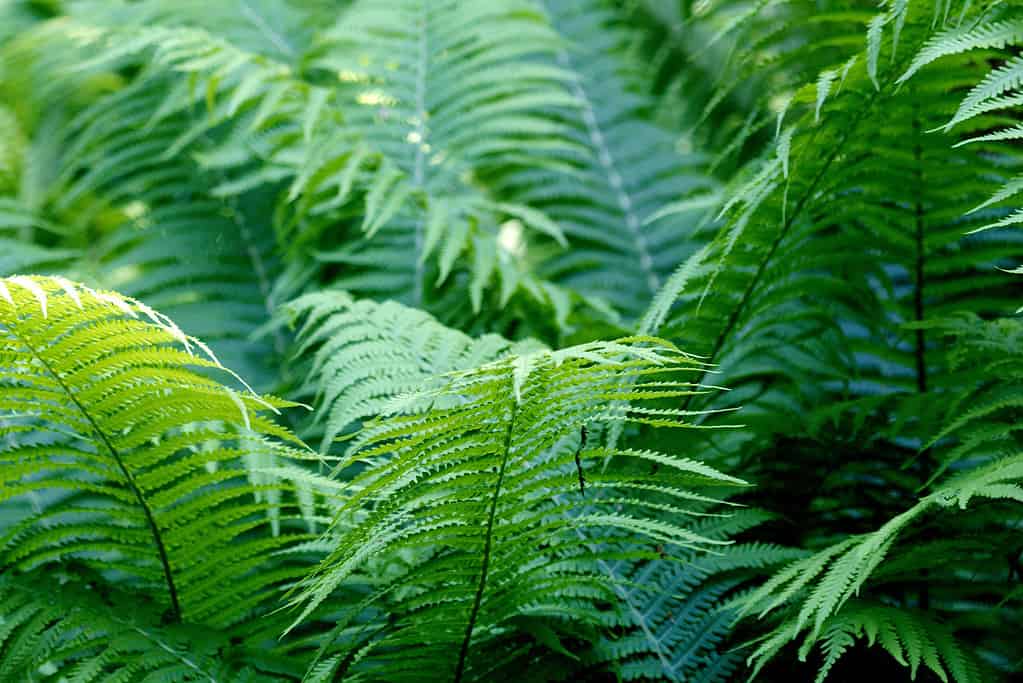
The giant chain fern is a deer-resistant evergreen that is perfect for those in USDA hardiness zones 8 to 9.
©Carnegie42/iStock via Getty Images
Popular among California garden lovers, the giant chain fern is a notable evergreen choice due to its deer resistance. This fern is characterized by its impressive size and distinctive apple-green fronds, which can reach up to 8 feet long. These fronds emerge from thick cinnamon-colored bases formed by short and robust rhizomes.
A unique feature of this fern is the small, broad clusters of sori found underneath its fronds, which can also be seen from the top. Interestingly, the giant chain fern holds the title of being North America’s largest fern and is naturally found anywhere from British Columbia to Mexico.
It’s been recognized by the Royal Horticultural Society, receiving its esteemed Award of Garden Merit due to its exceptional gardening attributes. The plant typically grows between 4 to 8 feet in both height and spread. An added bonus for gardeners is its natural resistance to most pests and diseases.
Growing Tips
- Best suited for semi-shaded to shaded areas.
- Prefers neutral to slightly acidic, moderately rich soil that remains moist.
- In colder regions, it’s essential to shield the plant from chilly, dry winds and provide some winter protection, like a dry mulch covering.
2. Johnny Jump Up (Viola tricolor)
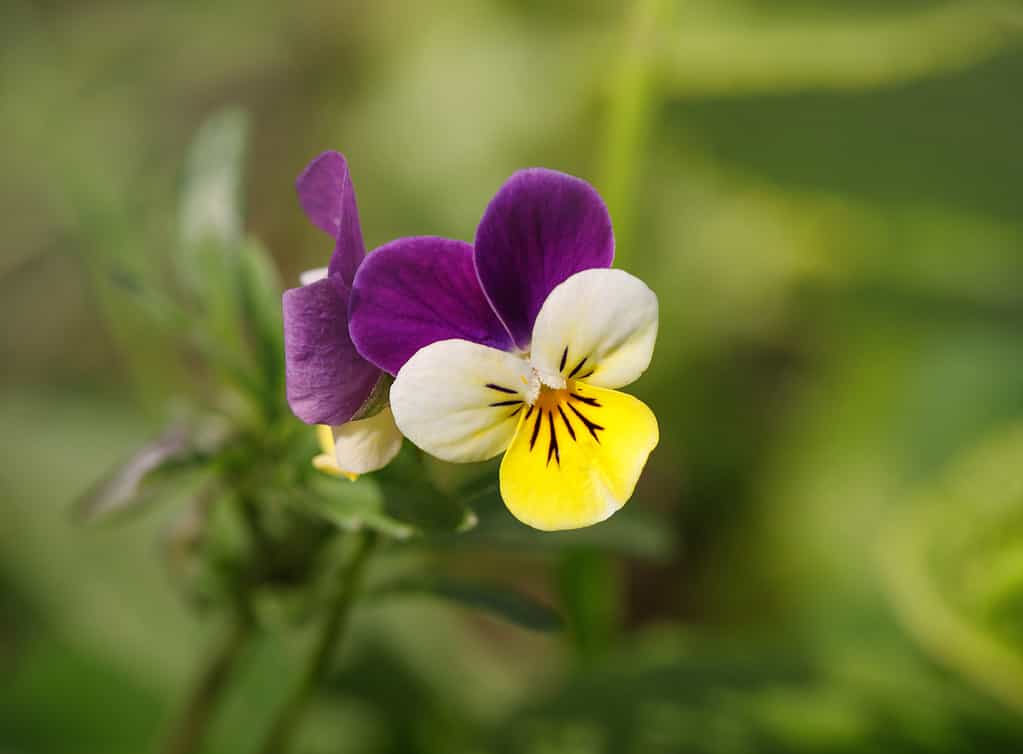
If you’re looking to add some gorgeous color to your garden, the Johnny Jump Up is a great deer-resistant evergreen.
©Marina Bagrova/iStock via Getty Images
The Johnny Jump Up is a versatile plant, which can be an annual, biennial, or short-lived evergreen perennial. It’s admired for its unique flowers that display a combination of deep purple, soft purple or yellow, and dark yellow hues, all arranged in a three-tone pattern. These blooms, measuring about an inch wide, stand atop its spreading stems.
These flowers grace gardens from spring through fall, thriving most in cooler temperatures. Interestingly, they might take a break and die back during the intense summer heat. The plant also boasts attractive, deep-green, oval-shaped leaves that are deeply lobed.
One fun trait of the Johnny Jump Up is its spontaneous nature; thanks to its abundant self-seeding, it often pops up in unexpected garden spots. This sprouting behavior is behind its playful name, suggesting its seeds “jump” around.
Growing to a modest height and width of 6 to 12 inches, it’s also known for its resistance to deer.
Growing Tips
- Thrives in areas with full sunlight to partial shade.
- Ideally planted in soil that’s moderately rich, retains moisture, and offers good drainage.
3. Star Jasmine (Trachelospermum jasminoides)
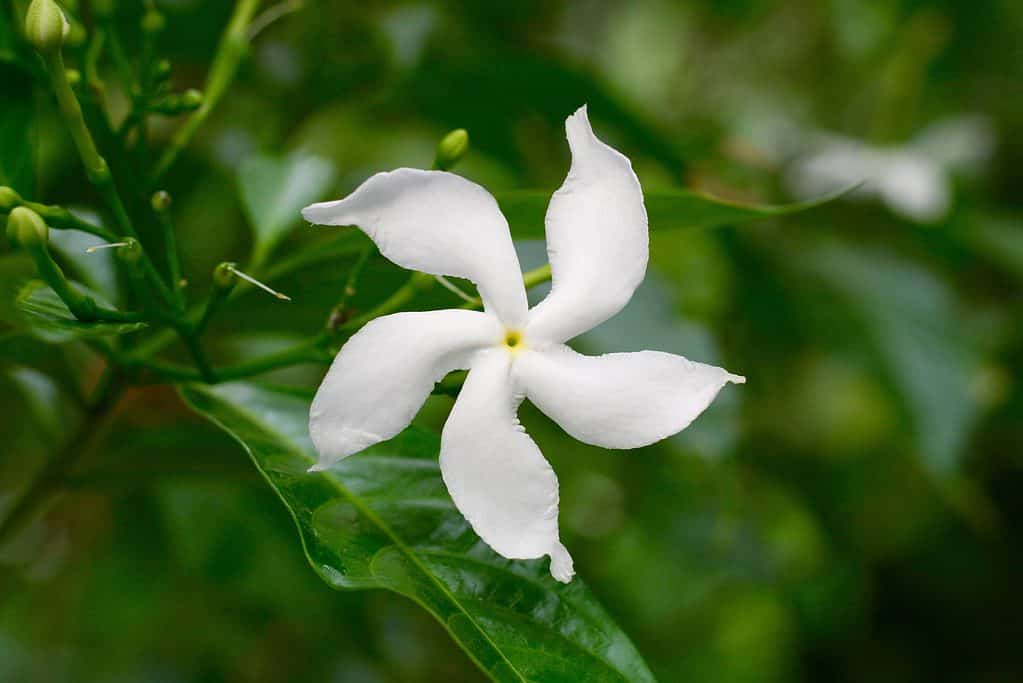
An evergreen shrub or vine with shiny, dark green leaves, the star jasmine is a gorgeous addition to any garden.
©maerzkind/Shutterstock.com
The star jasmine is an acclaimed evergreen shrub or vine known for its shiny, dark green leaves that can grow up to 3 inches long. These leaves, which initially have a bronze-purple hue, can adopt a bronze-red shade in cooler weather.
During the late spring and occasionally afterward, it blooms profusely, showcasing aromatic, star-like white flowers. As these flowers mature, they take on a creamy color. It’s a favorite choice for many gardeners who aim to bring life to privacy barriers and trellises or to soften the appearance of stone or concrete walls.
In its shrub form, it can achieve a height of about 2 feet, but when given a structure to climb, it can soar to heights of 10 to 20 feet. Resistant to many diseases and deer, the star jasmine is a go-to plant, especially for those new to gardening.
Growing Tips
- Best in areas with ample sunlight but can also handle partial shade.
- Opt for rich, well-draining soil.
- Shelter it from biting cold breezes.
- Once fully grown, it can tolerate drought conditions.
4. Spanish Broom (Spartium junceum)

Another deer-resistant evergreen you should definitely consider for your USDA hardiness zone 8 to 10 garden is the Spanish broom.
©NLink/iStock via Getty Images
The Spanish broom is a standout evergreen shrub known for its honey-vanilla aroma during the summer. This robust, medium-sized plant showcases yellow, pea-like blossoms that measure about an inch, appearing in the summertime. These blooms spring from slender, upright stems that resemble green brooms and eventually give way to flat green pods.
Originating from the Mediterranean, this resilient shrub is notable for its ability to flourish with minimal care. It particularly thrives in sunny locations with poor, well-draining soil. However, it’s worth noting that in certain U.S. states like California, Oregon, and Hawaii, it’s categorized as an invasive weed due to its rapid spread and potential to displace local vegetation.
The Royal Horticultural Society has acknowledged its gardening appeal with its esteemed Award of Garden Merit. Typically, this evergreen can grow between 6 to 10 feet in both height and width, though it looks best when maintained at a more compact size.
One of its advantages is its resistance to both drought and deer.
Growing Tips
- Prefers full sunlight.
- Does well in less fertile, well-draining soils.
5. Wild Stonecrop (Sedum ternatum)
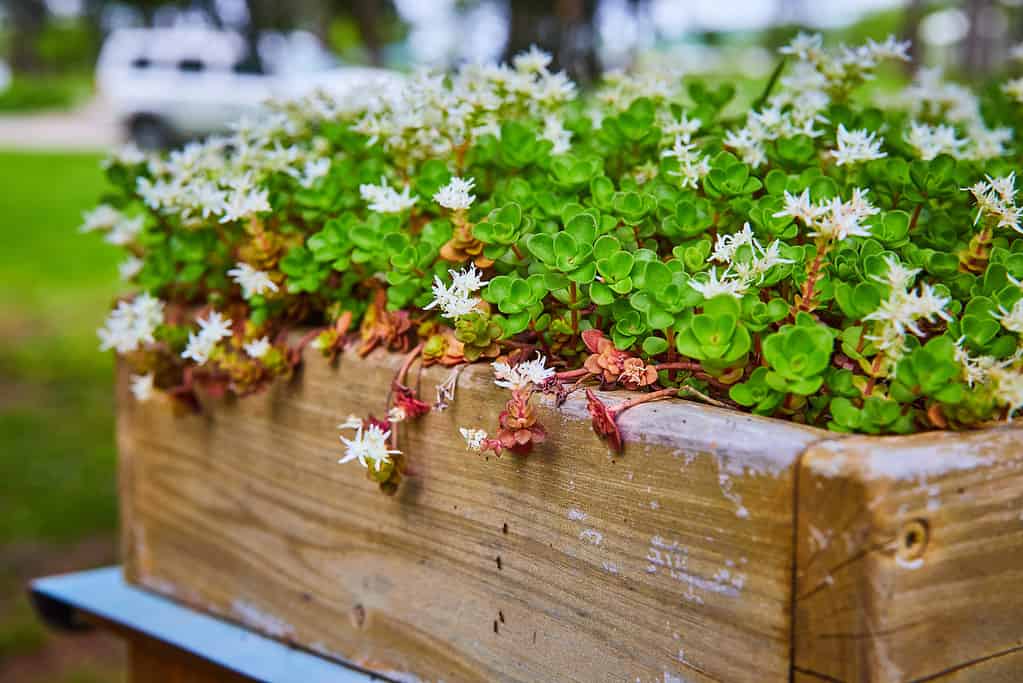
A low-lying evergreen perennial, the wild stonecrop is a great deer-resistant plant to add as succulent ground cover.
©Nicholas Klein/iStock via Getty Images
The wild stonecrop is a low-lying evergreen perennial characterized by its juicy, light-green leaves that stretch up to 4 inches long. These leaves are set in groups of three, giving it a unique appearance. When spring transitions to summer, this plant is adorned with small, radiant white flowers, which are accented by dark purple-black stamens.
This plant serves as an excellent succulent ground cover, especially in shaded areas or protected rock gardens. It’s particularly known for its low maintenance needs once it’s settled in. Among the native Sedum species in the eastern part of North America, Sedum ternatum is the most common.
In terms of growth, the wild stonecrop can reach heights of 3 to 6 inches and spread 6 to 9 inches wide. Its growth is supported by stems that spread out and take root at various points. Another plus is its strong resistance to most diseases and pests, although it’s good to be vigilant for botrytis. This plant is also unappealing to deer and rabbits.
Growing Tips
- Prefers areas with mild shade.
- Aim for average soil that ranges from moist to dry but ensures it drains well.
- Once matured, it can handle drought conditions.
6. Mojave Sage (Salvia pachyphylla)
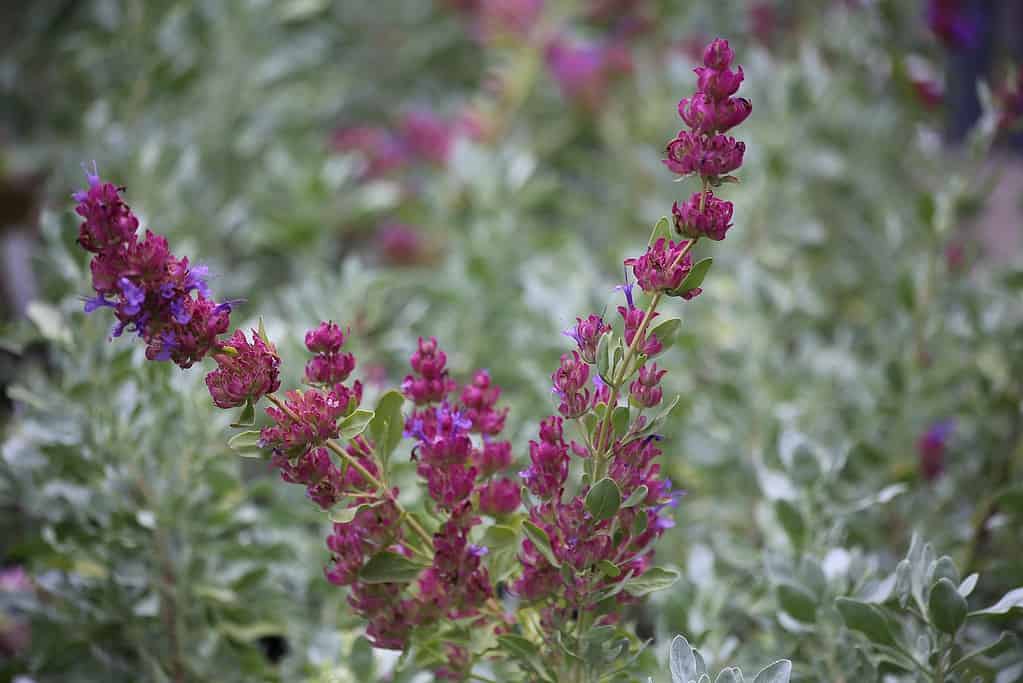
Boasting silvery gray leaves that have a pleasant scent, the Mojave sage is an evergreen shrub that is popular with pollinators but is deer-resistant.
©The Friends of Manito, Public domain, via Wikimedia Commons – Original / License
The Mojave sage is an eye-catching evergreen shrub that boasts silvery gray leaves, which carry a pleasant aroma, on its distinct square stems. Throughout the summer, it puts on a dazzling display with its deep blue-purple flower spikes. What makes these flowers even more striking is their size, which is larger than most sage varieties.
A popular choice for bees, hummingbirds, and butterflies, this Salvia variety offers gardeners multiple benefits. With minimal watering and care, it can endure both heat and cold while consistently showcasing its colorful blossoms for an extended period. It’s an excellent choice for water-conserving landscapes or xeriscaping.
In terms of size, it can grow to a height and spread of 2 to 3 feet. Apart from its ability to withstand dry conditions, it’s also resistant to deer and rabbits.
Growing Tips
- Best planted in areas receiving direct sunlight and in soil that drains well.
- Can survive in slightly shaded conditions.
7. Mountain Andromeda (Pieris floribunda)
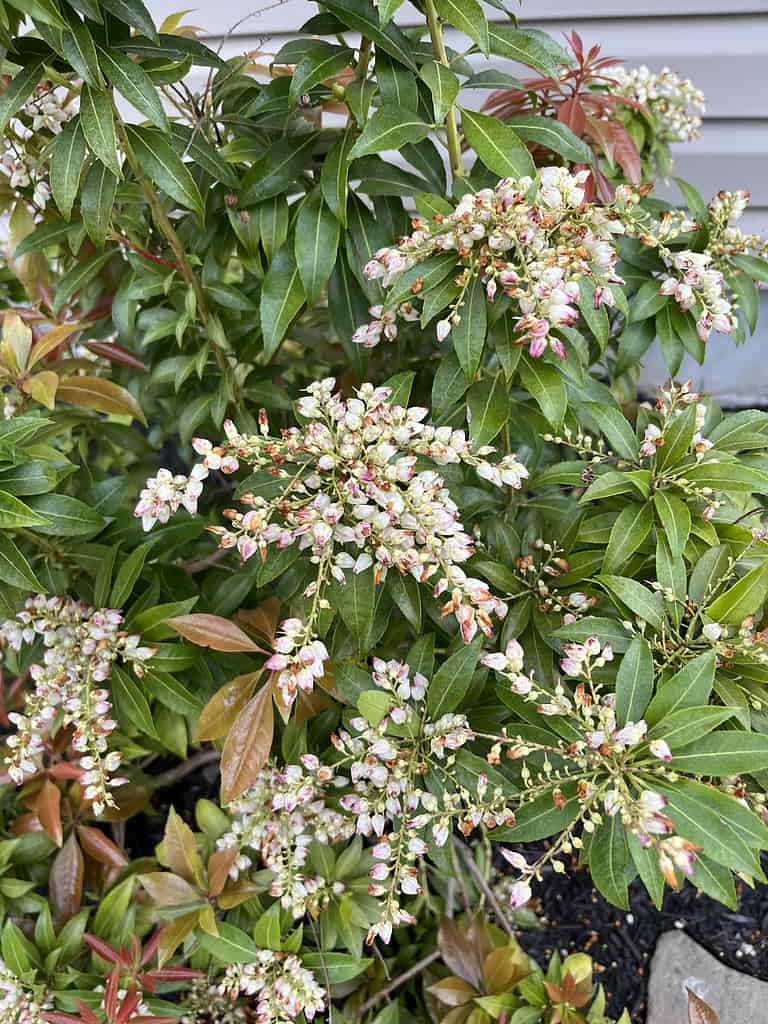
A thick, evergreen shrub that is gorgeous all year round, the mountain andromeda boasts white flowers.
©Jaclyn Vernace/iStock via Getty Images
The mountain andromeda is a thick, evergreen shrub known for its year-round appeal, from its winter charm to its spring blossoms and consistently colorful leaves. As winter approaches, eye-catching flower buds take shape, gradually shifting to a greenish-white hue.
By springtime, these buds unfurl to reveal creamy white, urn-like flowers that stand tall in pyramid-like clusters, drawing the attention of bees and bumblebees. The flowers stand out against a backdrop of glossy, deep green leaves with leathery texture. While it thrives in cooler climates, the mountain andromeda doesn’t perform well in hot and humid conditions.
Originating from the eastern U.S., it’s a top choice for gardens with acidic, well-draining soil.
This plant can reach heights of 4 to 6 feet and spans 3 to 4 feet in width. It’s important to note that it’s toxic to humans, dogs, cats, and horses.
Growing Tips
- Flourishes in areas with partial shade and prefers moist, acidic soil that drains well.
- Can endure direct sunlight but requires some shielding during winter to prevent damage.
- It’s also wise to place it away from harsh winds.
8. Pacific Wax Myrtle (Myrica californica)
The Pacific wax myrtle is a robust, evergreen shrub known for its upward-growing branches adorned with slender, dark-green leaves that have finely jagged edges. When these leaves are crushed, they release a distinct fragrance.
This plant is not only easy to grow but is also a visual treat, thanks to its berries and lustrous green leaves. It serves as a lovely centerpiece in a garden and can also enhance the backdrop of perennial plants. Its resilience to salt spray makes it a preferred choice for coastal gardens.
The Pacific wax myrtle can grow between 10 to 30 feet in both height and width, with an annual growth of about 24 inches. Though it’s resilient, it’s good to monitor for potential pests like thrips, spider mites, and whiteflies. An added advantage is its natural resistance to deer.
Growing Tips
- Thrives in both direct sunlight and partial shade and prefers slightly acidic soil that ranges from dry to moderately moist and offers good drainage.
- A sunnier spot results in a thicker growth.
9. Rose Campion (Lychnis coronaria)
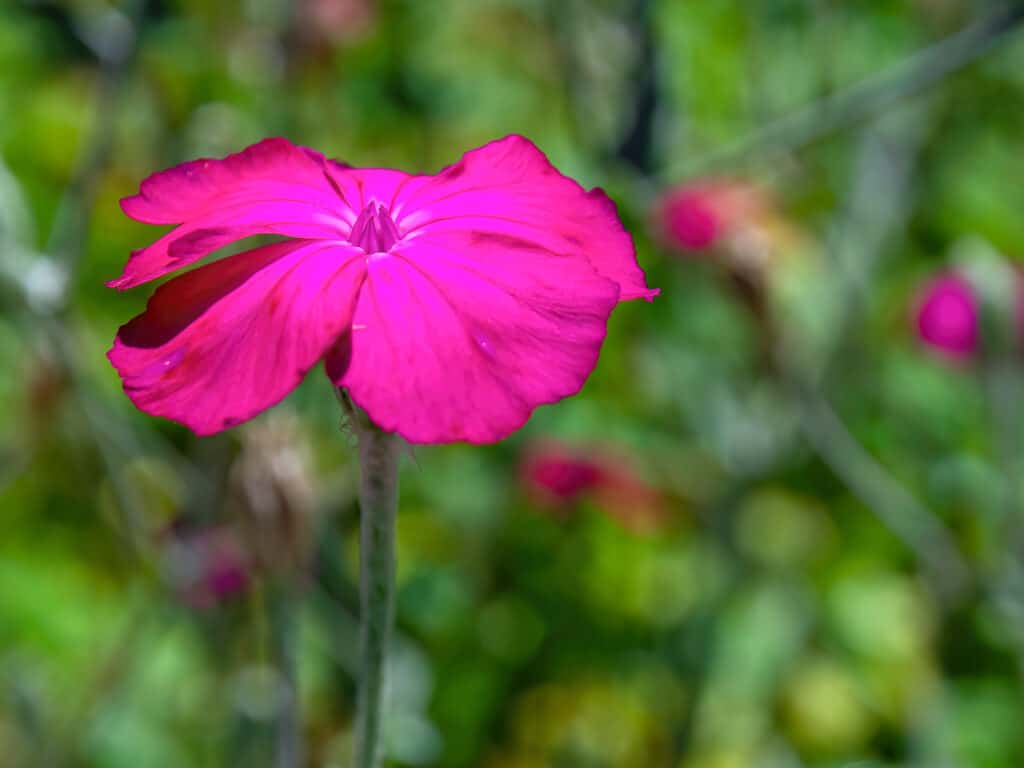
Another evergreen perennial that is deer-resistant is the rose campion, which grows best in full sun to partial shade.
©iStock.com/Mauricio Acosta
The rose campion is an evergreen perennial worth considering for any garden setting. With its tall white-gray stems bursting with flowers in shades of deep magenta, soft pink, or pure white, it’s both eye-catching and low maintenance. This plant remains lively throughout the year, making it a top pick for those seeking a perennial with lasting appeal.
Its charm isn’t just limited to its radiant flowers that bloom from late spring to late summer but also its base of fuzzy, silver-gray leaves that add a touch of winter beauty. Having earned recognition from the Royal Horticultural Society, it’s especially suited for dry landscapes, traditional cottage gardens, natural meadows, and perennial borders.
With a growth potential of 18 to 24 inches in height and an 18-inch spread, the rose campion is resistant to deer.
Growing Tips
- Best placed in areas with direct sunlight to partial shade.
- Prefers average, medium soils that drain well.
- While it favors moist conditions, it can manage in drier, less fertile soils. Ensure proper soil drainage for optimal growth.
10. Blue Lily Turf (Liriope muscari)

The blue lily turf is an evergreen perennial that showcases deep violet-purple flowers in late summer to fall.
©crystaldream/Shutterstock.com
Known primarily for its striking leaves, the blue lily turf is an evergreen perennial that grows in a thick bundle of slim, curving, dark green blades. At the end of summer and into fall, this plant showcases tall spikes adorned with clusters of deep violet-purple flowers. As fall progresses, these blossoms make way for glossy, black berries, which often linger into the winter months.
Compact and resilient, the lily turf shines, especially when planted in expansive patches or flowing patterns. Its versatility extends to serving as an alternative to traditional lawn grass.
Having received acclaim from the Royal Horticultural Society, this plant typically reaches a height and width of 12 to 18 inches. Another plus is its natural resistance to deer and rabbits.
Growing Tips
- Thrives in well-draining soil that’s slightly acidic and moderately fertile.
- Prefers areas with full sun to partial shade. It can also adapt to full shade, though this might lead to longer leaves and slower growth.
- In regions prone to frost, it’s wise to protect the plant from cold, harsh winds.
11. Mountain Laurel (Kalmia latifolia)

Mountain laurel is a gorgeous flower that boasts radiant pale pink blooms from late spring to early summer.
©JayL/Shutterstock.com
Connecticut‘s official state flower, the mountain laurel, is an evergreen shrub renowned for its profuse clusters of radiant pale pink blossoms. These blooms, which transition from deeper pink buds, grace gardens for multiple weeks between late spring and early summer. The flowers, with their bell-like shape and a blend of white and pink hues complemented by deep rose markings inside, eventually lead to brown fruit that remains visible through winter.
This plant’s all-season appeal includes its oval, shiny leaves that shift in hue from a refreshing light green to a deeper shade and even to hints of purple, bearing a resemblance to rhododendron leaves. Earning the Cary Award, it’s recognized for its adaptability to New England‘s climate, outstanding aesthetic value, resilience during winter, and resistance to pests.
Growing in a compact, rounded shape, it can reach heights of 5 to 15 feet. As a further plus, it is resistant to both deer and rabbits.
Growing Tips
- Ideally placed in partially shaded spots with moist, acidic, rich, and well-draining soil.
- Can adapt to a variety of light conditions, ranging from direct sunlight to complete shade.
12. Savin Juniper (Juniperus sabina)

The savin juniper is a deer-resistant, evergreen conifer that’s perfect for all types of gardens.
©Rvo233/iStock via Getty Images
Remarkably resilient, the savin juniper is an evergreen conifer known for its expansive or ground-hugging growth. Its slender branches are adorned with dark green leaves that maintain their color even during winter. The leaves have a unique scent, releasing an unusual odor when crushed. Mature stems of this juniper reveal a reddish-brown bark that naturally sheds in strips.
Appreciated for its year-round aesthetic appeal, this juniper serves as an excellent standalone plant or as part of a hedge, and it’s also effective in preventing soil erosion.
This plant is an ideal choice for various garden types, including coastal, urban, and cottage gardens. It’s also a fit for foundational landscapes or for planting on banks and slopes. With minimal care requirements, there’s no need for regular trimming.
Typically, it grows between 4 to 6 feet in height and can spread 5 to 10 feet wide. An added advantage is its natural resistance to deer.
Growing Tips
- Flourishes best under direct sunlight in medium moisture, well-draining soils.
- Adapts to various soil types, even clay.
- Once mature, it can handle dry conditions but doesn’t favor overly moist soil.
13. American Holly (Ilex opaca)
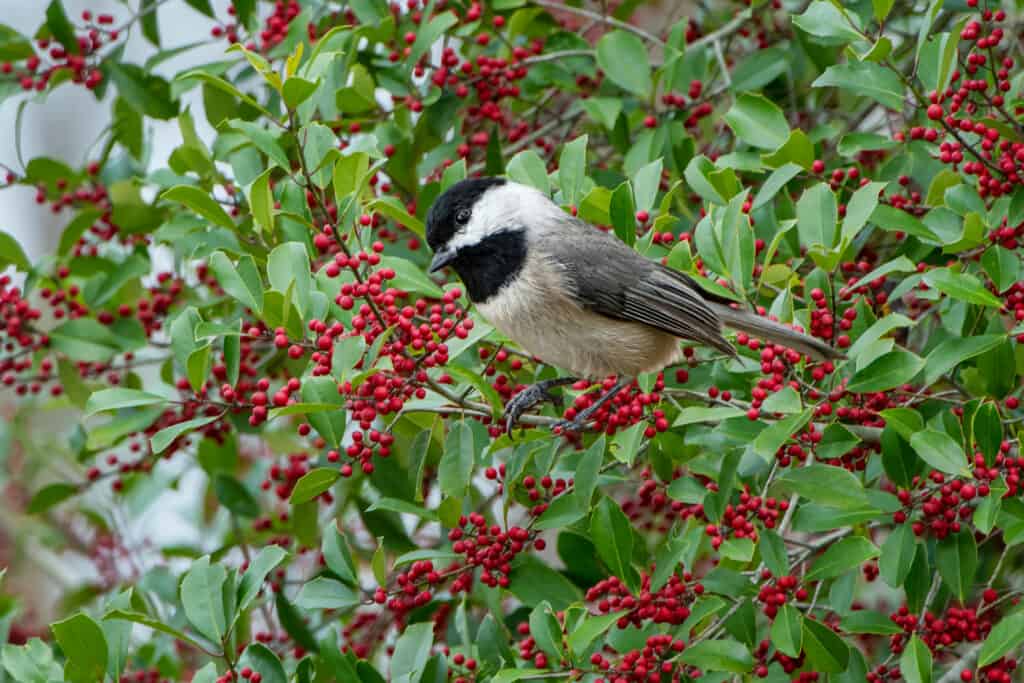
Birds love the American holly, another classic choice for an evergreen garden that is resistant to deer.
©Bonnie Taylor Barry/Shutterstock.com
Known for its iconic evergreen foliage, the American Holly is a classic choice for year-round garden beauty. This evergreen tree features glossy, dark green leaves with spiky, distinctive serrated edges and a leathery texture. During the winter months, its vibrant red berries stand out against the deep green backdrop, providing a festive touch to your landscape.
This versatile tree can serve as an ornamental plant in your garden, and its red-fruited branches make perfect holiday decorations indoors. Furthermore, its berries are a favorite among birds.
Typically, American Holly trees can reach heights of 15 to 30 feet and widths of 10 to 20 feet. These are relatively slow-growing trees, only adding 6 inches a year. Additionally, they are naturally resistant to deer. But you should keep an eye out for leaf rot, powdery mildew, whiteflies, spider mites, and holly leaf miners.
Growing Tips
- Thrives in well-drained, slightly acidic, moist soil.
- Prefers full sun to partial shade.
- Consider planting a male and female tree to ensure berry production.
Summary of Deer-Resistant Evergreens That Liven Up Any Yard
| Number | Deer-Resistant Evergreen | Botanical Name | USDA Hardiness Zone |
|---|---|---|---|
| 1. | Giant Chain Fern | Woodwardia fimbriata | 8 to 9 |
| 2. | Johnny Jump Up | Viola tricolor | 3 to 9 |
| 3. | Star Jasmine | Trachelospermum jasminoides | 8 to 10 |
| 4. | Spanish Broom | Spartium junceum | 8 to 10 |
| 5. | Wild Stonecrop | Sedum ternatum | 4 to 8 |
| 6. | Mojave Sage | Salvia pachyphylla | 5 to 9 |
| 7. | Mountain Andromeda | Pieris floribunda | 5 to 8 |
| 8. | Pacific Wax Myrtle | Myrica californica | 6 to 11 |
| 9. | Rose Campion | Lychnis coronaria | 4 to 8 |
| 10. | Blue Lily Turf | Liriope muscari | 5 to 10 |
| 11. | Mountain Laurel | Kalmia latifolia | 4 to 9 |
| 12. | Savin Juniper | Juniperus sabina | 3 to 7 |
| 13. | American Holly | Ilex opaca | 5 to 10 |
The photo featured at the top of this post is © Marina Bagrova/iStock via Getty Images
Thank you for reading! Have some feedback for us? Contact the AZ Animals editorial team.







